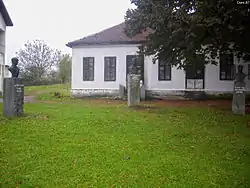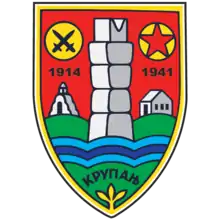Bela Crkva incident
Bela Crkva incident was an event that took place in village Bela Crkva near Krupanj on 7 July 1941, when a group of Partisans led by Žikica Jovanović Španac killed two gendarmes, who were enforcing ban on political rallies after German occupation of Serbia. The event was latter taken as beginning of uprising in Serbia led by Communist Party of Yugoslavia against Axis occupiers and their collaborators.

Background
After Yugoslav debacle in April War, Germany and their allies dismantled the Kingdom of Yugoslavia. Serbia proper was organized in occupation zone called Territory of the Military Commander in Serbia. Germans also set up a puppet Commissar Government of Milan Aćimović and kept pre-war gendamerie in order to maintain order. Germans also ban all political activities in their occupation zone.
Outlawed in the interwar period, the Communist Party of Yugoslavia began its preparations for an uprising as soon as Royal Yugoslav Army capitulated. German invasion on Soviet Union sped up activities of CPY. Also, Germans and their collaborators begun arresting man who were suspected of being communists. Politburo of Central Comity of CPY on its meeting held in Belgrade on 4th July 1941, (attained by Josip Broz Tito, Aleksandar Ranković, Milovan Đilas, Ivan Milutinović, Ivo Lola Ribar, Svetozar Vukmanović, Sreten Žujović) decided that time has come for armed resistance.[1] Next day, occupation authorities begun with killing hostages, as gendarmes shot 13 hostages (10 communists and 3 Jews).[2]
Western Serbia and Šumadija were regions where first partisans detachments were formed. Among them was Valjevo detachment with Rađevina company. Political commissar was journalist and teacher Žikica Jovanović Španac, a veteran of Spanish Civil War. Among others, in Rađevina company were physician Miša Pantić and teacher Čeda Milosavljević.
The incident
Sunday, 7th July was the day of the traditional village fair on Saint John's Day (according to Julian calendar). Vladan Bojanić, a law student, spread rumours that about a political rally would take place later that day. Village chief Sredoje Knežević attempted to disperse gathered people, but in vain.[1]
The group of 15 armed partisans entered Bela Crkva from nearby forest around 4 PM and headed toward the tavern to give a speech. Rally was started by village resident Bogoljub Rakić, a shoemaker and soldier of Rađevica company. Following him, Miša Pantić, Čeda Milosavljević and Žikica Jovanović addressed the gathered people from the steps of the tavern that was located there. They spoke about the shameful capitulation, about the occupation of the country and the regime of terror and exploitation, about domestic traitors who help the occupiers, about the Soviet Union and the strength of the Red Army, reminded the audience of the fighting traditions of this area, such as Cer, Mačkov kamen and Gučevo, and invited them to join the partisan ranks. Different sources and testimonies claim that the peasants responded positively to speeches,[3] and several young men decided to join them. After receiving new fighters, partisans headed in the direction of the forest where they came from. Bojanić remained in Bela Crkva.
Shortly after the departure of the partisans, a gendarmerie patrol from nearby village Zavlaka arrived in the village, which in the meantime was informed about the arrival of "armed communists".[3] Sergeant Bogdan Lončar and Corporal Milenko Braković were on patrol, and they began to ask about identity of partisans and disperse the gathered people to their homes.[3] Bojanić, then went after the partisans and told them about the arrival of the gendarmes, so Jovanović made the decision to return and disarm them. Approaching the place where the speech was held, they saw the crowd caused by the gendarmes. Partisans then took cover, and Jovanović continued across the clearing towards the gendarmes and the crowd. He was followed by three partisans. When he approached them about fifteen meters away, one of those gathered shouted at the gendarmes that the Partisans had arrived, to which they turned and shouted at Jovanović to surrender, to which he replied that they were handing over their weapons. One of the gendarmes then shot at Jovanović, but did not hit him, to which he responded almost simultaneously with shots from his Steyr M1912 pistol. Lončar was immediately fatally shot and fell to the ground, while the other was shot, but he also soon fell hit. At the same time, one of the partisans from Jovanović's entourage shot at the gendarmes. All sources agree that Jovanović killed Lončar, but it is unclear who exactly killed Braković.
After the shooting, Jovanović approached the killed gendarmes and took their rifles. These rifles were given to the new fighters who joined the company that day. To the gathered peasants, who were surprised by the speed of events and the unexpected turn of the situation, Jovanović said - "This is how all those who will serve the occupier will pass." After the action, Bojanić joined the company, as he could no longer stay in the village.
The action performed at the fair in Bela Crkva, quickly resonated in Rađevina and the entire Valjevo region. For days, there was talk about the appearance of partisans and their confrontation with the gendarmes. The people spun various stories, which were usually exaggerated, but the collaborationist press from Belgrade itself, writing about this event as the "beginning of communist riots in Serbia", spread the news about the appearance of partisans.[4]
Aftermath

Immediately after the liberation of Yugoslavia, on 27 June 1945, the National Assembly of Serbia made a decision to declare 7 July a holiday - the Day of the Uprising of the People of Serbia. Živorad Jovanović Španac, Miša Pantić and were also decorated by the Order of the People's Hero.
Holiday was celebrated until political changes in Serbia after downfall of Slobodan Milošević. New parliamentary majority led by Đinđić's Democratic Party and Koštunica's Democratic Party of Serbia on 9th July 2001 revoked decision from 1945. During the following years, representatives of state institutions and anti-communist individuals from the ruling civic parties, as well as revisionist historians, with parallel efforts of the Serbian Orthodox Church, tried to revise the historical event. At the beginning of 2000s, the remains of Lončar and Braković were exhumed and re-buried in the church of St. George in Bela Crkva.[5] They both were legally rehabilitated by a decision of Šabac district court in 2008.[6][7]
Reference
- Đureinović 2017, p. 66.
- Radanović 2012, p. 100.
- Đureinović 2017, p. 67.
- Đureinović 2017, p. 68.
- Radanović 2012, p. 104.
- Đureinović 2017, pp. 77-80.
- Radanović 2012, p. 83.
Sources
- Radanović, Milan (2012). "Zakonodavna politika Vlade Republike Srbije (2004–2011) u službi revizije prošlosti. Zakon o rehabilitaciji i njegova primena kao paradigmaistorijskog revizionizma u Srbiji". In Bešlin, Milivoj; Atanacković, Petar (eds.). Antifašizam pred izazovima savremenosti (PDF).
- Đureinović, Jelena (2017). "Reinterpretation of 7 July: From the Day When the First Insurgent Rifle Fired to the Day of the Outbreak of the Civil War". doi:10.31212/tokovi.2017.3.dju.59-84. Cite journal requires
|journal=(help)